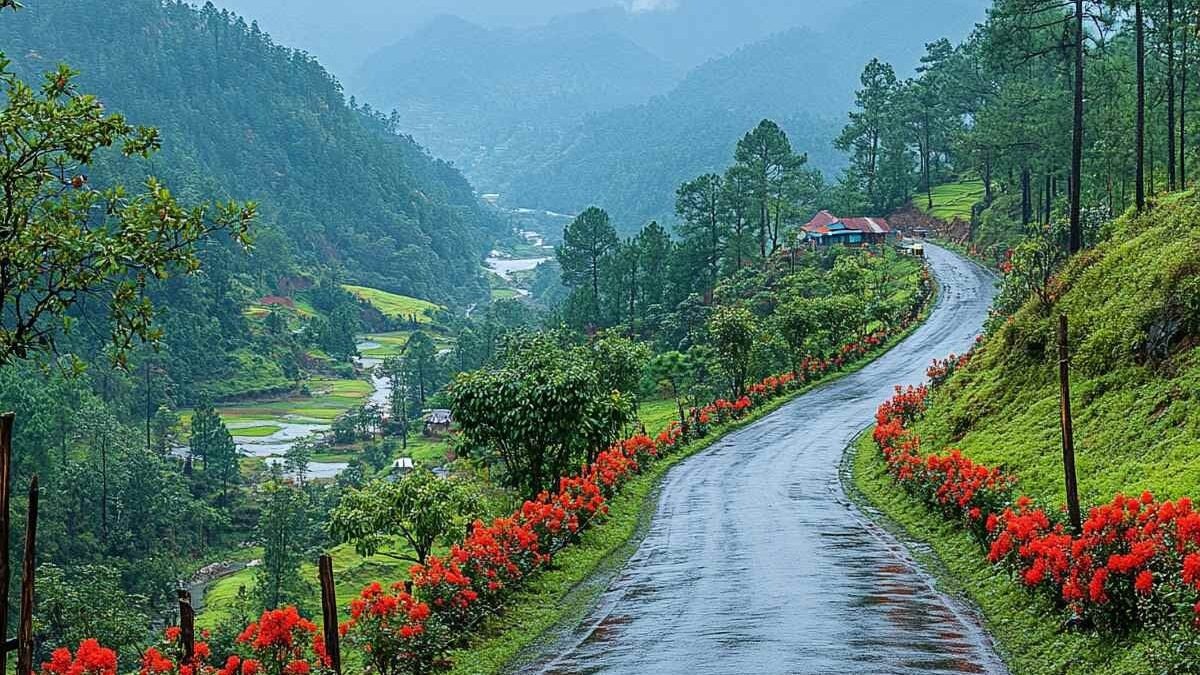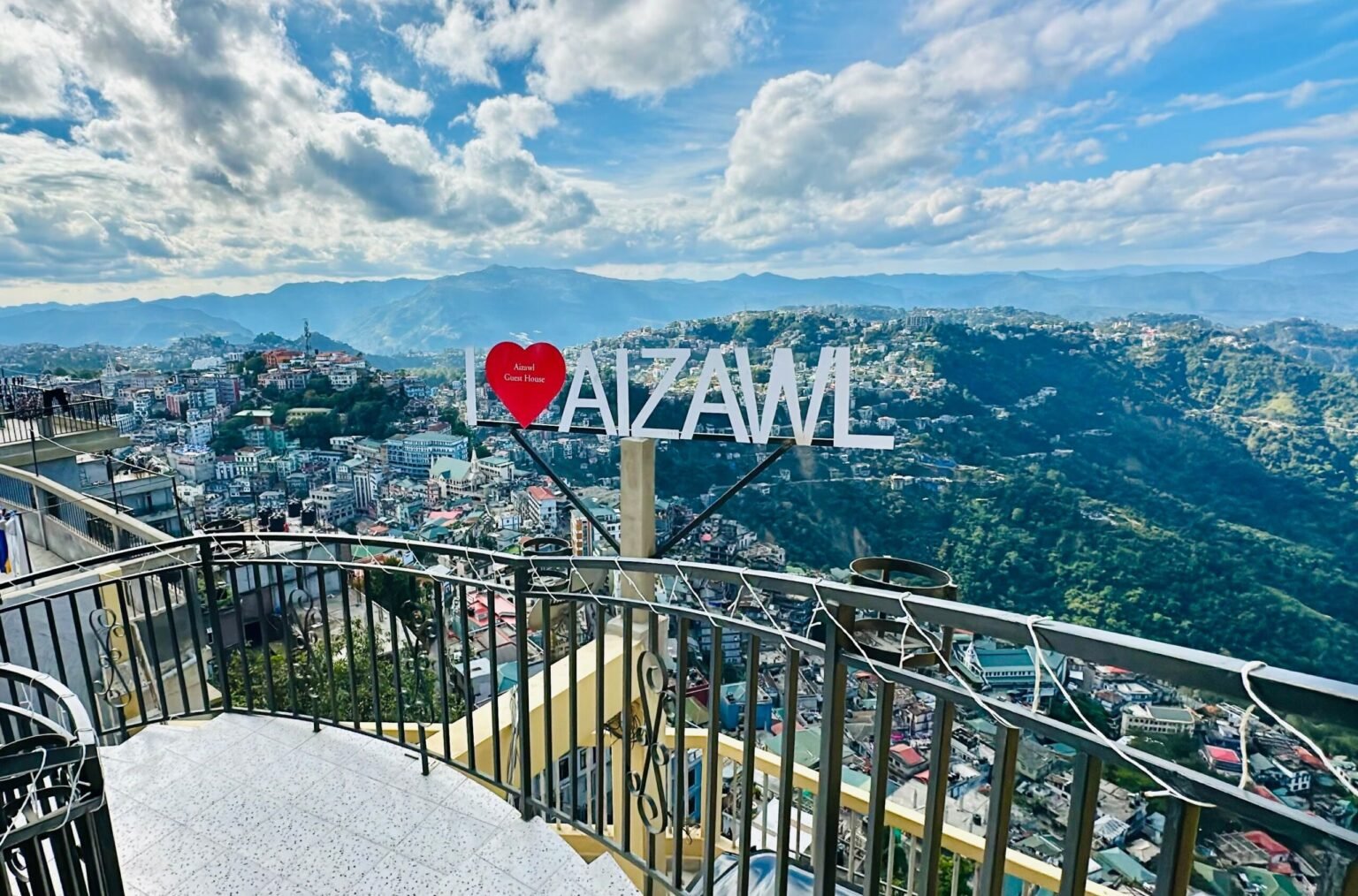Aizawl is the picturesque capital of Mizoram, India, known for its breathtaking hillscapes, vibrant culture, rich history, and welcoming community. Perched atop rolling ridges, the city offers spectacular vistas, colourful markets, and a unique blend of modern life with traditional Mizo heritage. It is a must-visit for travellers seeking both adventure and immersion in Northeast India’s unique way of life.
Nestled in the heart of the Lushai Hills, Aizawl stands out for its panoramic beauty, rich tribal traditions, and urban charm.
Geography and Location
Located at 23°43′38″N and 92°43′04″E, Aizawl sits 1,132 meters above sea level. The city is located in the north-central region of Mizoram, surrounded by stunning green ridgelines, with the Tlawng River to the west and the Tuirial River to the east. As of 2024, Aizawl’s population stands at about 415,000.
How to Reach Aizawl
- By Air: Lengpui Airport, located about 31 km from Aizawl, offers direct flights to Kolkata and Guwahati, making air travel the most convenient option.
- By Road: The city is connected to Silchar (Assam) via National Highway 6, offering a scenic journey of approximately 6-7 hours. There are regular buses and taxis from Silchar, Guwahati, and Imphal.
- By Rail: The nearest railway station is Silchar (172 km away). From there, buses and taxis travel regularly to Aizawl.
Key Details:
Quick Tips
- Best Overall Time to Visit: October–March offers a pleasant climate and is ideal for sightseeing, trekking, and festivals.
- Cost Variables: Prices for hotels, meals, local travel, and shopping can be higher during festivals and tourist peak season.
- Transport: Pre-booking for flights and hotels is recommended; local transport via shared taxi or private vehicle is readily available.
History of Aizawl
Aizawl, originally established around 1810 by Chief Lalsavunga, began as a small settlement and strategic point for regional chieftains. The British later developed it as the administrative capital of the Lushai Hills from 1898, leaving behind colonial-era architecture such as the Aijal Club and Raj Bhavan. It became a spiritual and educational hub with the advent of Christian missionaries, most notably the Welsh Mission Society. The city played a crucial role during the Mizo National Front movement and the subsequent peace accord in 1986, which ushered in enduring tranquillity and growth.
Aizawl’s Economy and Revenue
Aizawl drives much of Mizoram’s economy through government employment, trade, and emerging tourism. The city’s busy markets, like Bara Bazar, serve as commercial lifelines for the region’s handloom products, agricultural goods, and bamboo crafts. Local businesses, hospitality, and handicraft sectors are significant contributors to revenue, alongside public sector employment and small manufacturing.
Culture and Lifestyle
Aizawl is predominantly inhabited by the Mizo people, whose traditions are deeply woven into daily life. Christianity plays a pivotal role, with scores of churches forming the core of social activities. Annual festivals like Chapchar Kut and Thalfavang Kut feature elaborate dances, music, traditional attire, and grand feasts. The local language is Mizo, though English and Hindi are widely understood.
Culinary Highlights
Mizo cuisine is characterised by its freshness, use of bamboo shoots, leafy vegetables, and smoked meats. Signature dishes include:
- Mizo Thali (rice, bamboo shoot stir-fry, pork, and seasonal greens)
- Smoked pork with bamboo shoot
- Bamboo shoot stew
- Steamed fish in banana leaves
Local restaurants, such as Mama’s Heaven and Mizo Diner, offer authentic flavours, while markets provide an array of regional ingredients.
Tourist Spots and Places to Visit
Aizawl offers a mix of natural wonders and cultural landmarks:
- Durtlang Hills: Panoramic city views, hiking, and stargazing.
- Reiek Peak: Trekkers’ paradise with vistas over misty valleys.
- Falkawn Village: Live-in museum of traditional Mizo culture.
- Vantawng Falls: The 13th-highest waterfall in India, surrounded by lush forest.
- Dampa Tiger Reserve: Wildlife safaris and bird-watching opportunities.
- Solomon’s Temple: The city’s grandest Christian landmark, known for its architecture and serene gardens.
- Bara Bazar: Bustling marketplace for local textiles, crafts, and street food.
- KV Paradise: Mausoleum known as Mizoram’s “Taj Mahal,” a testament to love and artistry.
Notable Places Near Aizawl
- Tam Dil Lake: Sought for picnics and boating, about 80 km from the city.
- Hmuifang Peak: Adventure and camping destination.
- Reiek Heritage Village: Showcases traditional Mizo homes and festivals.
Major Festivals
- Chapchar Kut: Springtime festival, marked by bamboo dances, music, and feasting.
- Thalfavang Kut: Celebrating the completion of community work before the harvest.
- Christmas and New Year: Large-scale celebrations with carols, church gatherings, and community feasts.

Accommodation in Aizawl
Travellers can choose from a range of hotels and guest houses, such as:
| Name | Address | Contact |
|---|---|---|
| Hotel Regency | Zarkawt, Aizawl | 0389 234 9334 |
| Emerald Hotel | Treasury Square, Aizawl | 0389 231 7477 |
| Hotel Ransam | Thuampui Vengthar | 090895 25221 |
| Esquire | Mission Veng, Aizawl | 0389 232 3809 |
| Jojo’s Nascere | Zarkawt Main Road, Aizawl | 0389 234 3135 |
Best Time to Visit
- Winter (November–February): Pleasant weather, clear skies, and festive events.
- Monsoon (June–September): Lush landscapes but frequent rain.
- Summer (March–May): Warm but manageable, best for sightseeing and outdoor activities.
Useful Travel Tips
- Permits: Most Indian nationals need an Inner Line Permit (ILP) to visit Mizoram, available through Mizoram House offices in other major cities.
- Local Transport: Shared taxis, buses, and rental cars are common in the city. Walking is convenient in many hillside areas.
- Language: English signage is prevalent; learning a few Mizo greetings enhances the experience.
- Safety: Aizawl is safe, but hilly roads can be challenging. Carry essentials and confirm operating times for sites in advance.
Current News and Developments
In 2025, Aizawl is experiencing rapid enhancements in public infrastructure, including participation in India’s Smart Cities Mission. Recent headlines highlight a crackdown on permit fraud at events, government efforts to boost job success rates among youth, and a plan for a large 2,400 MW hydroelectric power project, reflecting the city’s dynamic and forward-looking environment.
FAQs About Aizawl
What makes Aizawl unique among Indian cities?
Aizawl stands out for its dramatic hillside views, harmonious blend of tradition and modernity, lively bazaars, and spiritual depth rooted in Mizo Christian culture.
Is Aizawl safe for tourists?
Yes, Aizawl is regarded as one of the safest cities for tourists in northeast India, with friendly locals and a peaceful atmosphere.
What is the best way to reach Aizawl?
The most convenient ways are by flight via Lengpui Airport or by road from Silchar, Assam. The region does not have a major railway station within city limits.
What are the top must-visit places in Aizawl?
Top sights include Durtlang Hills, Vantawng Falls, Bara Bazar, Reiek Peak, Falkawn Village, and Solomon’s Temple.
Do I need a special permit to visit Aizawl?
Yes, an Inner Line Permit (ILP) is required for most non-residents visiting Mizoram.
What are the main festivals in Aizawl?
Chapchar Kut (spring) and Thalfavang Kut (post-harvest) are major festivals marked by vibrant communal activities.
How is the food in Aizawl?
Expect healthy, lightly spiced dishes with bamboo shoots, greens, and pork; markets and restaurants serve both traditional and fusion cuisines.
Which nearby getaways are popular from Aizawl?
Popular getaways include Tam Dil Lake, Hmuifang, and Reiek Heritage Village, ideal for nature lovers and trekkers.
